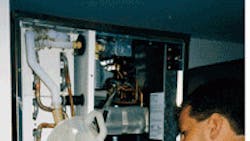Preventive Maintenance (PM) is the key to maximum running efficiency, less down time, and longer life out of an ice machine. The primary items for an ice machine PM check are as follows:
- Clean and sanitize the water system.
- Clean air filters on air-cooled models.
- Check external filter system and change cartridges as needed.
- Check inlet water valve screens.
- Conduct bearing and auger inspection on extruded ice makers.
- Conduct a visual inspection of components, controls, and wiring for oil spots, loose wires, loose fasteners, corrosion, etc.
- Clean the bin interior and unit exterior.
Clean and Sanitize
As ice forms on an ice machine evaporator plate, a separation occurs. Minerals separate from the water and form scale which sticks to the surfaces of the water system components. This scale will be more visible when the surfaces are dry. The color of the scale will vary due to the type of minerals in the local water supply. As an example, lime or calcium scale will be off white in color while iron scale will turn a rusty red color. Algae or slime growth may also occur in some locations. This is due to air or water-borne bacteria which can settle in the wet areas and grow.
On a cuber evaporator plate, this scale build-up insulates the freezing surface and impedes heat transfer. If the scale build-up remains, the ice cubes will stick to the plate and not harvest properly. As the next cycle continues, excessive ice will freeze on the evaporator plate and cause what is commonly known as a freeze-up. On auger-driven Flaker or cubelet machines, the scale sticks to the inside of the barrel and causes low production and poor quality ice. The scale build-up must be removed. This is accomplished by circulating a mild phosphoric acid solution throughout the water system.
Cleaning instructions are generally included in the instruction manual shipped with the unit. For quick reference, Hoshizaki, for example, provides a cleaning label on the inside of the front panel. To avoid damage to the unit always follow the manufacturers cleaning instructions. Use the correct type and mixing solution for the cleaner. Units which have plated evaporators require the use of a nickel safe cleaner. Nickel safe cleaner has a weaker acidic solution to protect the plating surface. Any available commercial ice machine cleaner can be used on Hoshizaki's stainless steel evaporator plates as long as the cleaner has 30% or less phosphoric acid as recommended.
Once the cleaning process is complete, the unit should be sanitized. Follow the sanitizing instructions using a commercial ice machine sanitizer or 5% sodium hypochlorite solution, such as household bleach. This is especially important if algae or slime is present. The sanitizer will eliminate any bacteria present and retard further growth. You should not exceed the recommend mixing solution and the system should be rinsed the system thoroughly after sanitizing.
The storage bin should also be cleaned and sanitized at this time. Thoroughly flush the water system and bin before putting the unit back into operation. This will ensure hat your customer has clean, fresh ice.
Clean and Inspect
While you are waiting for the cleaning solution to do its job during the cleaning process, you can complete other steps in the PM check.
Clean the condenser and/or air filter if included on the unit, and check the inlet water valve screen for restriction. Clean condenser fan blades.If the condenser coil is covered with grease, grime or dirt, use a non-corrosive cleaner and rinse thoroughly with water. You may find it necessary to use a fin comb or brush on the coil fins. This is especially important on remote condenser units where the coil is subjected to outside elements.
For water cooled condenser units, the water connections of the condenser coil must be disconnected and cleaning solution circulated through the coil. The water regulating valve must be cleaned and re-adjusted for proper flow once the cleaning process is completed. Service or change the filter cartridge on the external water filter/treatment system if present.
Inspect the control box and electrical components for loose or burnt connections. Look over the refrigeration system and service access valves for oil spots or other evidence of leaks. A complete, visual inspection of the unit can point to future problems, and will allow you time to correct the problem before expensive down time occurs.
Flaker Bearing and Auger Inspection
Flakers produce ice on or inside an evaporator cylinder. The ice is broken away and extruded out of the cylinder by a gear motor-driven auger. Bearings allow the auger to rotate and maintain its positioning in the evaporator cylinder. Since the auger turns, bearing wear is eminent. A flaker bearing is a wear item. These bearings should be inspected per the manufacturers' recommendations.
Hoshizaki recommends at least annual bearing inspections. More frequent inspections may be necessary in bad water areas especially if no water treatment is used. This is a simple check of the top bearing with a .02-in. wire feeler gauge. An additional visual inspection of the auger and bearing surface is also recommended as the units get older. All assembly fasteners should be securely tightened and checked periodically to assure they do not loosen under stress.
Clean Exterior
The final step in the PM process is to clean the exterior. Use a soft cloth and a neutral cleaner to wipe down the stainless exterior of the unit and storage bin.
If conducted on a regular basis, preventative maintenance checks will save time and money. PM's will also keep you busy in your slower season. Use every opportunity as a service expert to sell your ice machine customer on the benefits of routine PM inspections. You and your customers will benefit greatly.
This file type includes high resolution graphics and schematics when applicable.
Danny Moore is director, technical support for Hoshizaki America, Inc.

